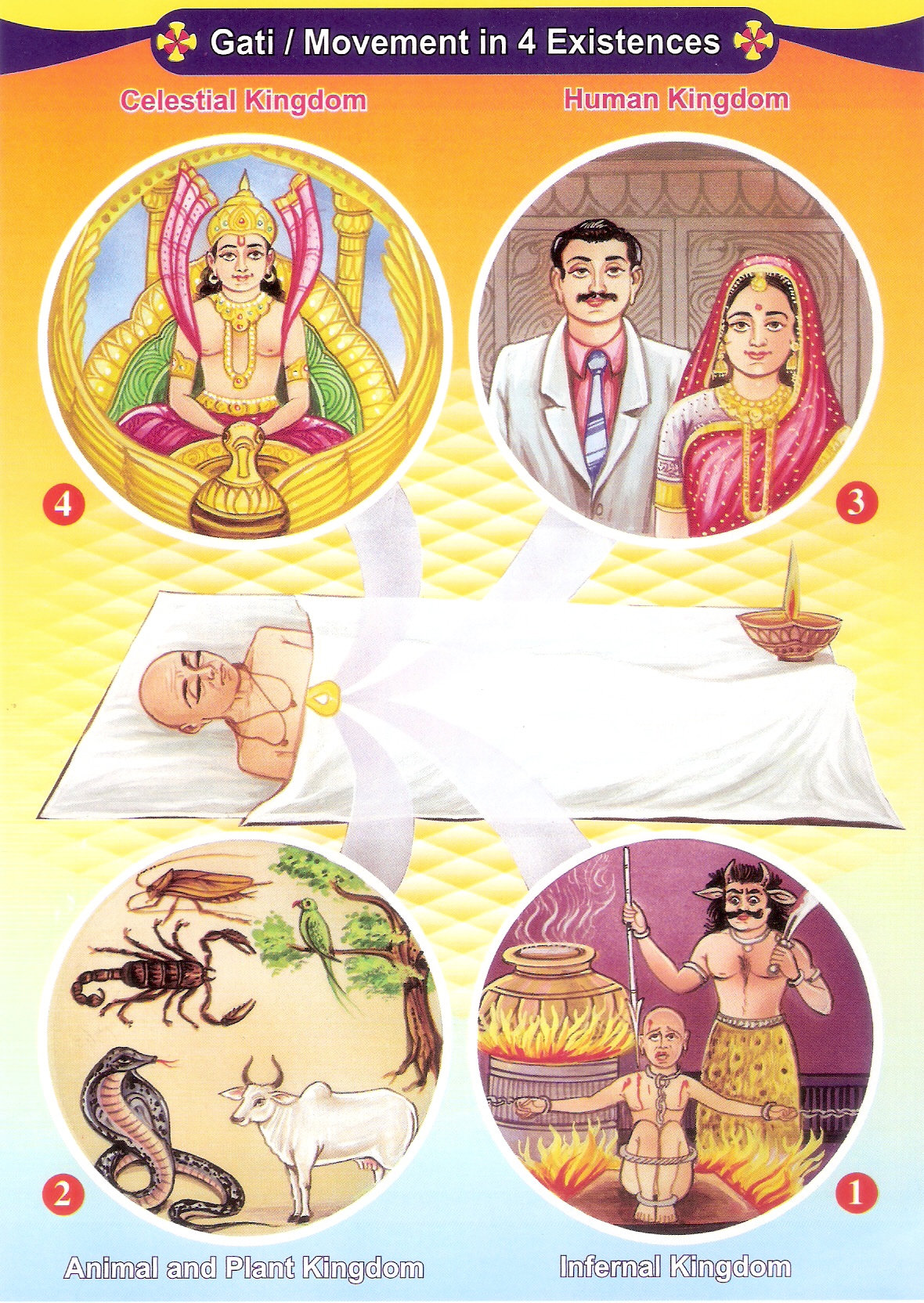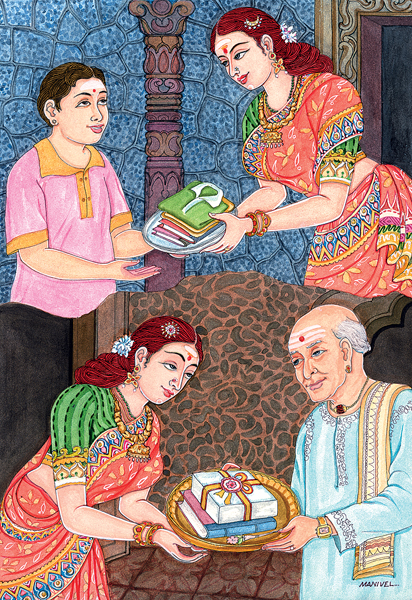|
Mokṣa
''Moksha'' (; , '), also called ''vimoksha'', ''vimukti'', and ''mukti'', is a term in Jainism, Buddhism, Hinduism, and Sikhism for various forms of emancipation, liberation, ''nirvana'', or release. In its soteriological and eschatological senses, it refers to freedom from ''saṃsāra'', the cycle of death and rebirth. In its epistemological and psychological senses, ''moksha'' is freedom from ignorance: self-realization, self-actualization and self-knowledge. In Hindu traditions, ''moksha'' is a central concept and the utmost aim of human life; the other three aims are ''dharma'' (virtuous, proper, moral life), ''artha'' (material prosperity, income security, means of life), and ''kama'' (pleasure, sensuality, emotional fulfillment). Together, these four concepts are called Puruṣārtha in Hinduism. In some schools of Indian religions, ''moksha'' is considered equivalent to and used interchangeably with other terms such as ''vimoksha'', ''vimukti'', ''kaivalya'', ''apava ... [...More Info...] [...Related Items...] OR: [Wikipedia] [Google] [Baidu] |
Puruṣārtha
''Purushartha'' (Sanskrit: पुरुषार्थ, IAST: ) literally means "object(ive) of men". Cappeller Sanskrit-English Dictionary, Koeln University, Germany It is a key concept in , and refers to the four proper goals or aims of a human life. The four ''puruṣārthas'' are (righteousness, moral values), (prosperity, economic values), ... [...More Info...] [...Related Items...] OR: [Wikipedia] [Google] [Baidu] |
Samkhya
Samkhya or Sankhya (; ) is a dualistic orthodox school of Hindu philosophy. It views reality as composed of two independent principles, '' Puruṣa'' ('consciousness' or spirit) and '' Prakṛti'' (nature or matter, including the human mind and emotions). ''Puruṣa'' is the witness-consciousness. It is absolute, independent, free, beyond perception, above any experience by mind or senses, and impossible to describe in words. ''Prakṛti'' is matter or nature. It is inactive, unconscious, and is a balance of the three '' guṇas'' (qualities or innate tendencies), namely '' sattva'', '' rajas'', and '' tamas''. When ''Prakṛti'' comes into contact with ''Purusha'' this balance is disturbed, and ''Prakṛti'' becomes manifest, evolving twenty-three tattvas, namely intellect ('' buddhi'', ''mahat''), I-principle ('' ahamkara''), mind ('' manas''); the five sensory capacities known as ears, skin, eyes, tongue and nose; the five action capacities known as hands (''hasta''), fee ... [...More Info...] [...Related Items...] OR: [Wikipedia] [Google] [Baidu] |
Reincarnation
Reincarnation, also known as rebirth or transmigration, is the Philosophy, philosophical or Religion, religious concept that the non-physical essence of a living being begins a new lifespan (other), lifespan in a different physical form or physical body, body after biological death. In most beliefs involving reincarnation, the soul of a human being is immortality, immortal and does not disperse after the physical body has perished. Upon death, the soul merely becomes transmigrated into a newborn baby or into an animal to continue its immortality. (The term "transmigration" means the passing of a soul from one body to another after death.) Reincarnation (''punarjanman'') is a central tenet of Indian religions such as Hinduism, Buddhism, Jainism, and Sikhism. In various forms, it occurs as an esoteric belief in many streams of Judaism, in certain Paganism, pagan religions (including Wicca), and in some beliefs of the Indigenous peoples of the Americas and of Australian ... [...More Info...] [...Related Items...] OR: [Wikipedia] [Google] [Baidu] |
Hinduism
Hinduism () is an Hypernymy and hyponymy, umbrella term for a range of Indian religions, Indian List of religions and spiritual traditions#Indian religions, religious and spiritual traditions (Sampradaya, ''sampradaya''s) that are unified by adherence to the concept of ''dharma'', a Ṛta, cosmic order maintained by its followers through rituals and righteous living, as expounded in the Vedas. The word ''Hindu'' is an exonym, and while Hinduism has been called the oldest religion in the world, it has also been described by the modern term ''Sanātana Dharma'' () emphasizing its eternal nature. ''Vaidika Dharma'' () and ''Arya dharma'' are historical endonyms for Hinduism. Hinduism entails diverse systems of thought, marked by a range of shared Glossary of Hinduism terms, concepts that discuss God in Hinduism, theology, Hindu mythology, mythology, among other topics in Hindu texts, textual sources. Hindu texts have been classified into Śruti () and Smṛti (). The major Hin ... [...More Info...] [...Related Items...] OR: [Wikipedia] [Google] [Baidu] |
Soteriology
Soteriology (; ' "salvation" from wikt:σωτήρ, σωτήρ ' "savior, preserver" and wikt:λόγος, λόγος ' "study" or "word") is the study of Doctrine, religious doctrines of salvation. Salvation theory occupies a place of special significance in many religions. In the academic field of Religious studies, soteriology is understood by scholars as representing a key theme in a number of different religions and is often studied in a Comparative religion, comparative context; that is, comparing various ideas about what salvation is and how it is obtained. Buddhism Buddhism is devoted primarily to Enlightenment in Buddhism, awakening or enlightenment (''bodhi''), ''Nirvana (Buddhism), Nirvāṇa'' ("blowing out"), and Moksha, liberation (''vimokṣa'') from Duḥkha, all causes of suffering (''duḥkha'') due to the existence of Sentient beings (Buddhism), sentient beings in ''Saṃsāra (Buddhism), saṃsāra'' (the cycle of compulsory Rebirth (Buddhism), birth, death, ... [...More Info...] [...Related Items...] OR: [Wikipedia] [Google] [Baidu] |
Eschatology
Eschatology (; ) concerns expectations of the end of Contemporary era, present age, human history, or the world itself. The end of the world or end times is predicted by several world religions (both Abrahamic religions, Abrahamic and non-Abrahamic), which teach that negative world events will reach a climax. Briefly: the eschaton is the all-inclusive term evoking this predicted climax of a particular theological or political worldview. The scope of expected consequence is global and not local. Eschatology denotes the theory, discussion, techniques, behaviors and orientation toward the eschaton. Theories of afterlife may also be a dimension of eschatology in certain contexts—in these contexts the afterlife of an individual is a kind of hologram or particular microcosm of the overall eschaton. The Eschaton is, furthermore, related to telos: a Greek word simultaneously denoting purpose, climax and end (ie. death, terminus etc. but also perfection, completion etc.). Eschaton is t ... [...More Info...] [...Related Items...] OR: [Wikipedia] [Google] [Baidu] |
Suffering
Suffering, or pain in a broad sense, may be an experience of unpleasantness or aversion, possibly associated with the perception of harm or threat of harm in an individual. Suffering is the basic element that makes up the negative valence (psychology), valence of affective phenomena. The opposite of suffering is pleasure or happiness. Suffering is often categorized as physical or mental. It may come in all degrees of intensity, from mild to intolerable. Factors of duration and frequency of occurrence usually compound that of intensity. Attitudes toward suffering may vary widely, in the sufferer or other people, according to how much it is regarded as avoidable or unavoidable, useful or useless, deserved or undeserved. Suffering occurs in the lives of Sentience, sentient beings in numerous manners, often dramatically. As a result, many fields of human activity are concerned with some aspects of suffering. These aspects may include the nature of suffering, its processes, its orig ... [...More Info...] [...Related Items...] OR: [Wikipedia] [Google] [Baidu] |
Psychology & Developing Societies
''Psychology and Developing Societies (PDS)'' is a peer-reviewed journal. It serves as a forum for discussion for psychologists from different parts of the world concerned with the problems of developing societies. In pursuit of that aim, the journal especially encourages articles which reflect the unique sociocultural and historical experience of developing countries and provide alternative paradigms, indigenous concepts and methods which have relevance for social policy in these countries. It is published twice a year by SAGE Publishing. Abstracting and indexing ''Psychology and Developing Societies'' is abstracted and indexed in: * ProQuest: International Bibliography of the Social Sciences (IBSS) * SCOPUS * Research Papers in Economics * DeepDyve * Portico * Dutch-KB * Pro-Quest-RSP * EBSCO * OCLC * Ohio * ICI * ProQuest-Illustrata * PsycINFO PsycINFO is a database of abstracts of literature in the field of psychology. It is produced by the American Psychological Ass ... [...More Info...] [...Related Items...] OR: [Wikipedia] [Google] [Baidu] |
Jivanmukta
A ''jivan mukta'' or ''mukta'' is someone who, in the Advaita Vedanta philosophy of Hinduism, has gained and assimilated self-knowledge, thus is liberated with an inner sense of freedom while living. The state is the aim of moksha in Advaita Vedanta, Yoga and other schools of Hinduism, and it is referred to as ''jivanmukti'' (Self-realization).Gerhard Oberhammer (1994), La Délivrance dès cette vie: Jivanmukti, Collège de France, Publications de l'Institut de Civilisation Indienne. Série in-8°, Fasc. 61, Édition-Diffusion de Boccard (Paris), , pages 1-9 Jivanmukti contrasts with the concept of '' videhamukti''; the latter means "liberation or emancipation after death, in afterlife". Etymology ''Jīvanmukta'' () is an adjective derived from a combination of Sanskrit noun जीव '' jīva'', "life", and the past participle of the verb मुच् (much, or IAST muc), "to liberate". Monier-Williams gives the meaning "emancipated while still alive". ''Jīvanmukti'' (), the ... [...More Info...] [...Related Items...] OR: [Wikipedia] [Google] [Baidu] |
Jainism
Jainism ( ), also known as Jain Dharma, is an Indian religions, Indian religion whose three main pillars are nonviolence (), asceticism (), and a rejection of all simplistic and one-sided views of truth and reality (). Jainism traces its spiritual ideas and history through the succession of twenty-four , supreme preachers of ''dharma''. The first in the current time cycle is Rishabhadeva, who tradition holds lived millions of years ago; the 23rd is Parshvanatha, traditionally dated to the 9th century Common Era, BCE; and the 24th is Mahāvīra, Mahavira, who lived . Jainism is considered an eternal ''dharma'' with the guiding every time cycle of the Jain cosmology, cosmology. Central to understanding Jain philosophy is the concept of ''bhedavijñāna'', or the clear distinction in the nature of the soul and non-soul entities. This principle underscores the innate purity and potential for liberation within every Jīva (Jainism), soul, distinct from the physical and menta ... [...More Info...] [...Related Items...] OR: [Wikipedia] [Google] [Baidu] |
Punya (Hinduism)
Punya (), also rendered punyam () is a concept in Hinduism with various definitions. It generally refers to virtue or merit, and the activities that allow one to acquire this attribute, in order to achieve liberation from samsara, the cycle of birth and death in the material world. A single act of vertue which creates a bundle of vertues at a time is called Mahapunya means Mega-vertue. Definitions ''Punya'' is referred to as good ''karma'' or a virtue that contributes benefits in this and the next birth and can be acquired by appropriate means and also accumulated. In Vedanta terms ''punya'' is the invisible wealth, a part of ''dharma'', the first of four human goals; the other three goals being ''artha,'' ''kama, and moksha''. ''Punya'' and '' pāpa'' are the seeds of future pleasure and pain, the former, which sows merits, exhausts itself only through pleasure and the latter, which sows demerits, exhausts itself only through pain; but '' jivan mukti'' ends all karmic debts cons ... [...More Info...] [...Related Items...] OR: [Wikipedia] [Google] [Baidu] |
Karma
Karma (, from , ; ) is an ancient Indian concept that refers to an action, work, or deed, and its effect or consequences. In Indian religions, the term more specifically refers to a principle of cause and effect, often descriptively called the principle of karma, wherein individuals' intent and actions (cause) influence their future (effect): Good intent and good deeds contribute to good karma and happier Reincarnation, rebirths, while bad intent and bad deeds contribute to bad karma and worse rebirths. In some scriptures, however, there is no link between rebirth and karma. In Hinduism, karma is traditionally classified into four types: Sanchita karma (accumulated karma from past actions across lifetimes), Prārabdha karma (a portion of Sanchita karma that is currently bearing fruit and determines the circumstances of the present life), Āgāmi karma (future karma generated by present actions), and Kriyamāṇa karma (immediate karma created by current actions, which may y ... [...More Info...] [...Related Items...] OR: [Wikipedia] [Google] [Baidu] |






